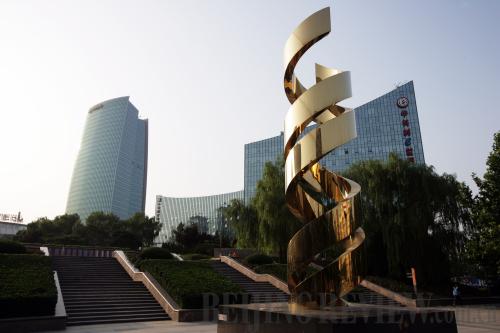|
 |
|
MODEL FOR SUCCESS: In March 2009, the State Council gave its approval to develop the Zhongguancun Science Park in Beijing's Haidian District into a national innovation model park (WANG XIANG) |
In 2006, the Chinese Government launched a national campaign to press ahead with its indigenous innovation strategy, a program meant to break the nation's reliance on foreign enterprises for new technologies and put the nation on track to become a hi-tech innovator.
A series of recently introduced Central Government policies will help the strategy develop smoothly and gain momentum. In November 2009, the Ministry of Science and Technology, National Development and Reform Commission, and Ministry of Finance jointly issued a notice on the national indigenous innovation product accreditation that year. In April 2010, the draft notice for this year was released. This move will give priority to indigenous innovation products in government purchases.
In interviews with Beijing Review, two economists and experts in this regard provided an in-depth analysis on the country's indigenous innovation strategy and the way it is carried out.
The Chinese Government has put its indigenous innovation strategy into action. So what does "indigenous innovation" mean? Why has the government advocated it? What benefits will it bring to the country? Qi Jianguo, Deputy Director of the Quantitative and Technical Economics Institute under the Chinese Academy of Social Sciences, shared his views on these issues in an interview with Beijing Review reporter Ding Wenlei. Edited excerpts follow:
Beijing Review: China has spared no effort to promote indigenous innovation. Would you explain what is significant about this strategy?
 |
|
QI JIANGUO |
Qi Jianguo: In an era of globalization and growing interdependence, major economies are reciprocally affected by each other's economic policies. Every country is trying to get its economy back on track with incentives following the financial crisis.
Overseas audiences may have a blurred view of the real meaning of China's indigenous innovation proposal. It was already clarified in the National Medium- and Long-term Science and Technology Development Plan (2006-2020) that indigenous innovation consists of three types: original innovation; integrated innovation; and acquired and assimilated advanced foreign technologies used to invent new products.
Original innovations start with new ideas and end with products or industries developed from homegrown technologies suiting the Chinese market.
Integrated innovations incorporate various technologies, regardless of origin, into different products, and have been widely applied toward technological inventions. We're not too concerned about the origins of these technologies—they can be homegrown or imported, or modern or ancient. We can incorporate whatever we get through legitimate means to meet the country's needs.
And in terms of the third type of innovation, we stress the importance of acquiring advanced foreign technologies for assimilation, improvement and reinvention. We emphasize that this kind of innovation based on imported technologies also falls into the category of indigenous innovations.
Therefore, China will hold intellectual property rights (IPRs)—which could be the rights to decide prices, design, as well as marketing—for products developed based on domestically innovated technologies. As a result, we will manage, modify and dispose of these products and innovations according to the market.
China has never meant to pursue innovations and production completely independent of the global market. The innovation system is an inclusive one that emphasizes assimilating advanced foreign technologies and inventing new products. The proposal itself doesn't shut the door on technological applications based on acquisitions of advanced foreign technologies and products, nor does it discriminate against foreign capital.
Why is China advocating indigenous innovation at this stage of economic and social development?
Domestically, it's because China's manufacturing sector doesn't control most core technologies for its products, particularly in hi-tech areas, despite remarkable growth in recent years. About 80 percent of those core technologies are in the hands of multinationals and, as a result, most products made in China are relatively low added value. For many of these products, we can make them but are not allowed to alter the design.
Take the auto-making industry for example. China recently became the world's biggest auto manufacturer, but except for two automakers using homegrown technologies—Geely and Chery—we produce cars mostly for overseas brands. As such, we can only produce cars in line with engineering drawings the overseas companies provide and are prohibited from altering even the tiniest detail. The production and finished products of China's auto industry are therefore dominated by multinationals, and restricted by the patent system and other institutional barriers.
Our hope is that Chinese enterprises will soon be able to independently design and manufacture their own products. Developed countries already reached this frontier, and as IPR owners are able to modify designs according to the needs of different markets. If Chinese enterprises want to follow suit, they have to shake off the restrictions from others' patents by developing original technologies and designs.
| 